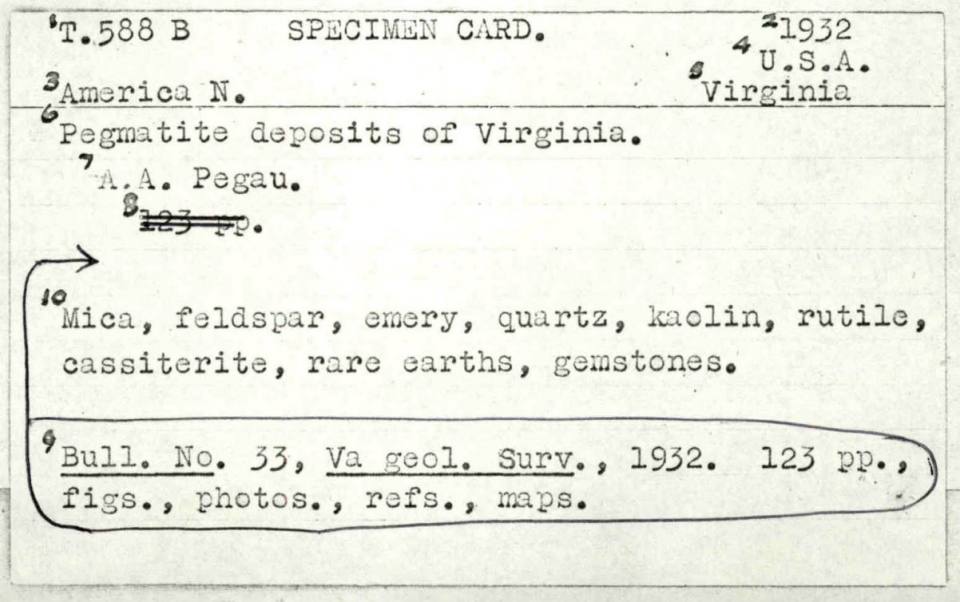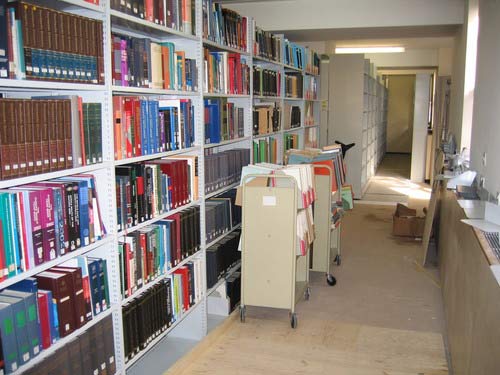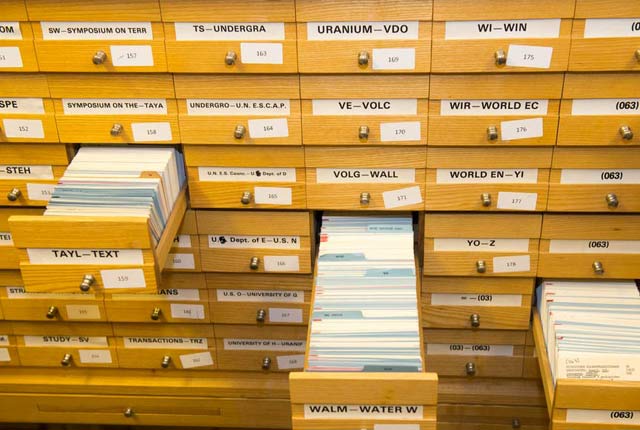The BGS Mineral Index is card catalogue of mineral intelligence references covering the years 1917–1980.
As a pre-digital age work, it contains information that is now hard to find. It includes references not only to traditional geological publications but also to a much wider range of economic and local, in-country sources. It looks at all mineral commodities, each being subdivided into six main subsections:
- general
- countries (of occurrence)
- mining
- preparation and treatment
- uses
- markets, valuation and prices
BGS Mineral Index online
While the original card catalogue was arranged by commodity, in this digital version we have been able to present the catalogue in two sequences: alphabetically by country and alphabetically by commodity.
Over the lifespan of the card catalogue, many of the country or region place names and often the borders have changed. Sections can be found under earlier and current names. To fully research a country, users need to look at the different sections: for example, for Botswana also check Bechuanaland; for Namibia also check South West Africa. A full list of former country names is maintained by Wikipedia.
History of the BGS Mineral Index (by David G Bate, 31 March 2021)
It was agreed at the Imperial War Conference of 1917 to set up an Imperial Body, which would be charged with the duties of collecting information regarding the mineral resources and metal requirements of the British Empire. The Imperial Mineral Resources Bureau was set up in June 1919 for this purpose. The Mineral Index, a bibliographic card index documenting the occurrence, mining, processing and uses of mineral raw materials around the world, was established within the Intelligence and Publications Section of the bureau. Bibliographical information extracted from publications and reports from around the world was collected systematically for the period 1917 onward and older references were added on an ad hoc basis.
The bureau was amalgamated with the Mineral Resources Department of the Imperial Institute in 1925. In 1949, the department became the Mineral Resources Division of the Directorate of Colonial (later Overseas) Geological Surveys. Finally, in 1965, Overseas Geological Surveys was joined with the Geological Survey of Great Britain to form the Institute of Geological Sciences, now the British Geological Survey.
By 1980, approximately 400 000 bibliographic citations had been added to the Mineral Index. In that year, a computerised database was set up to replace the handwritten indexing of geological and minerals-related literature. An online bibliographic database called MinSearch succeeded the old card index, but in 1985 reductions in Government funding led to its demise. None of the data from the period 1980 to 1985 was preserved.
Original instructions for the card catalogue (1967)
Mineral Index
Certain sections are classified by uses of groups of mineral commodities, e.g. refractories; pigments. Each of their subsections maybe subdivided into six sections (general; countries, etc.). In addition, certain of these sections do not readily fall into the ‘Mineral’ classification, e.g. ‘Policy, mining law’, ‘General geology’, ’Geophysics’, etc.
In those sections listing widely occurring minerals (e.g. coal; copper; iron) the main subdivisions may be further broken down, e.g. ‘Mining, boring’ or ‘Preparation and treatment, concentration’.
The ‘Countries’ section of each item is divided into ‘World’, ‘Commonwealth’ and ‘Foreign’, the last two being subdivided into continents in the following order:
- Europe
- Africa
- America N
- America S
- Asia
- Australasia
- Antarctica
Individual countries are listed alphabetically within their respective continents.
All literature taken by the former Overseas Division is searched, the following information being recorded, in manuscript, on 5″ × 3″ index cards:
- location (i.e. Library Class Mark) [Former OGS system]
- date (of publication)
- continent (if describing an item geographically)
- country (if describing an item geographically)
- province, county or state (if describing an item geographically)
- title of paper or article
- author(s)
- size of article (i.e. number of pages or paragraphs)
- reference
- abstract or descriptor, if subject is not readily clear from title (this would indicate geographical position, extent, properties, reserves, grade of ore, analyses, geology, mining methods, methods of extraction, ore dressing, marketing, prices, etc.)

Sample specimen card for the pegmatite deposits of Virginia, USA. BGS © UKRI.
The section in which the card is to be filed is recorded on the back of the card.
Papers and books not held in the BGS Library, which are borrowed from other libraries in connection with departmental enquiries, etc., are indexed in the normal way, but the reference is written in red, unless a copy of the article is made.
Cards are filed in date order in their respective sections and subsections and alphabetically by author within each year.
Searching the BGS Mineral Index
- Main section, e.g. ‘ALUMINIUM, bauxite, Guyana’: will give references on the specific subject.
- Mineral resources section: will contain references on the minerals. occurring in specific countries that may not be covered by the main section.
- Mineral trade notes section: contains ‘running’ cards giving references to information (mainly statistical) published in the periodical Mineral Trade Notes of the US Bureau of Mines.
- Nomenclature: gives the location in the index of any subject that is not readily apparent from the headings of the main sections.
- General geology: contains information recorded geographically that may aid the enquirer in the possible location of economic mineral deposits.
In addition, the enquirer should always refer to the regular publications of global geological and mines departments (e.g. annual reports of geological surveys; the Minerals Yearbook of the US Bureau of Mines) and trade journals (e.g. annual review numbers of Engineering Mining Journal, Mining Journal, Eastern Metals Review) and similar publications.
The indexing staff will be pleased to help in case of difficulty.
Contact
Please contact BGS Library for more information.
You may also be interested in
Scanned records
Open access to a number of our digital scan collections, including borehole log scans and published maps.
BGS Library
We have extensive collections of books, maps, journals and BGS publications. We also hold special collections of British geological photographs and archive material, chiefly the historical archives of the BGS.

Library online card catalogue: author/title sequence
BGS Library by author/title sequence.

Library online card catalogue: UDC
Universal Decimal Classification (UDC) sequence for geographic areas.


